11 Community and stakeholders
Learning Objectives
- Understand the importance of community and stakeholder relationships in sports marketing.
- Evaluate the impact of corporate social responsibility (CSR) in the sports industry.
- Develop effective community plans and strategies for sports organisations.
- Develop and implement effective stakeholder engagement plans and programs
- Evaluate the success of community and stakeholder engagement strategies in the sports industry
Introduction
Sports organisations play an essential role in their communities, and their influence can have a significant impact on society. By supporting various initiatives that promote health and fitness, education, diversity, and inclusion, sports organisations can make a positive difference. Through their involvement in community initiatives, sports organisations can strengthen their relationships with all different kinds of stakeholders, including fans, sponsors, athletes, employees, and governing bodies.
Building strong relationships with the community: CSR
Building stronger relationships through community involvement can enhance a sports organisation’s reputation and contribute to its success. By aligning their community involvement with their brand values and objectives, sports organisations can create a positive impact on society while enhancing their brand image. Sport fans increasingly seek to support socially responsible and sustainable organisations, and sports organisations that engage in community initiatives can differentiate themselves from their competitors.
One way sport teams do this is by adopting to the principals of CSR. CSR stands for “Corporate Social Responsibility”. In its basic term it is a business model that involves companies taking responsibility for their impact on society, both economically and socially.
Companies are expected to act in the best interest of their community and their stakeholders- including customers, employees, shareholders, and the wider community[1].
Research has found that Corporate Social Responsibility (CSR) has a positive impact on marketing performance, and it is made up of different dimensions that relate differently to various stakeholders. One way to create a CSR perception of a brand is through sponsoring charities and professional sports teams[2].
Sports provide stakeholders/business organisations to establish a socially responsible image due to sports unique position in society and the emotional attachment to sport teams people have. Sponsorship therefore creates a halo effect where consumers’ goodwill towards a sports team rubs off on a sponsoring brand.
Therefore, through sponsorship of consumer-favoured sport teams, other business brands can generate a socially responsible image in the eyes of consumers[3].
The video below are comments made by members of various football organisations talking about why CSR is important as a tool to also give back to the community (we can’t be too negative to the intentions of brands here!)[4]
Let’s have a look at how the premiers of the NRL are making an impact on their community.
Penrith Panthers: Panthers on the prowl
Penrith Panthers, as part of their CSR, have a community program called “Panthers on the Prowl”, which supports children through access to programs and resources promoting healthy lifestyles and initiatives targeting at-risk students. The Panthers have developed a close relationship with over 250 schools in Western Sydney, and the Penrith Junior Rugby League is the largest Rugby League nursery in the country.
The Panthers also provide partnership opportunities for businesses to (co)deliver Corporate Social Responsibility obligations and engage with the community.
The teams community programs are designed around a 4 pillar framework: Education, Social Inclusion, Engagement, and Healthy.
Have a look at the Panthers website and watch the below video to find more about the specific programs they have created to give back to their community[5].
It is important to remember that to create successful community programs, it’s essential for a sport team to have a deep understanding of the community they represent. This includes knowledge of the community’s demographics, the challenges and issues faced by different groups within the community, and the community’s needs and aspirations.
By having this understanding, sport teams can create programs that are tailored to the specific needs of the community, ensuring they are effective and well-received. Additionally, by engaging with the community and getting feedback on their programs, sport teams can continually improve and adapt their initiatives to better meet the community’s needs.
Creating a (good) community plan
To create an effective community plan, sports organisations should identify the needs and interests of their communities and align them with their brand values and objectives. For example, they can partner with local organisations and non-profits to support initiatives that align with their values and objectives.
By communicating their community involvement initiatives effectively, sports organisations can showcase their positive impact on society and enhance their reputation. Ultimately, community involvement can benefit both the sports organisation and the broader society it serves.
It is important to remember that when implementing a community strategy, clubs need to to clearly outline their goals, the type of program they will deliver, the external partners they will engage to help deliver the program, the target group for the program, and the desired outcomes of the community strategy.
Clear goals help clubs to identify the specific outcomes they want to achieve through their community programs. A well-defined program design ensures that clubs deliver activities that align with their goals, and that are appropriate for their target audience.
Engaging external partners helps to expand a club’s reach and resources, and to ensure that their programs are more effective and relevant to the community they are serving.
Identifying the target group for the program helps clubs to ensure that their programs are tailored to meet the specific needs of their community – with a very specific focus (this could be related to targeting individuals from particular age, gender or cultural background
Finally, outlining desired outcomes ensures that clubs can measure the impact of their programs, and determine whether they have achieved their goals.
Let’s look at an example on the Bulldogs website that related to the “multicultural” pillar of their strategy and how they have implemented a program in their local community.
For example, the Canterbury-Bankstown Bulldogs engaged with their local community to develop their community strategy that was collaborative and unique to their local area. Throughout this process, the Bulldogs and their local community, identified the following ‘community pillars’ that they believe will highlight and address local social needs. These are: Multicultural, Arts and Culture, Participation.

Bulldogs Community Strategy: Multiculturalism Pillar
Goal: Leverage the power of sport to create a harmonious community by actively engaging and celebrating our proud diverse community.
Program: Motivating classroom students to be active in the community.
External Partners: Canterbury League Club, Community Minds Inc, Western Sydney University and City of Canterbury Bankstown
Target Group: Primary school children aged 9-11, Canterbury-Bankstown area
Outcomes: Increase community and civic participation among children, Improved and increased community connectedness of students, Increase engagement between Bulldogs and school children, Increase participation in junior rugby league, Increased sense of pride in community, Shifting mindsets from deficit thinking to positive asset-based thinking
(please note this is adapted from their website)
As we can see, community involvement can have a broader impact on society, beyond the immediate benefits to the sports organisation. By supporting health and fitness initiatives, sports organisations can promote physical and mental well-being in their communities.
By supporting education initiatives particularly, they can provide opportunities for learning and skill-building in new and exciting way. By supporting diversity and inclusion initiatives, they can promote a more equitable and just society.
Evaluation of community programs
This week I am asking you to read through the “Her Sport Her Way Grant Program Evaluation report” [6]
As the video[7] above shows, the Her Sport Her Way Grants was a grant program initiated by the New South Wales (NSW) government in Australia to support initiatives aimed at increasing the participation of women and girls in sports.
The program was part of the NSW Government’s women in sport strategy, which aimed to create gender-inclusive sports environments. The grants were awarded to state sporting organisations (SSOs) and state sporting organisations for people with disabilities (SSODs), to develop and deliver initiatives towards this goal.
The program was evaluated to monitor changes in the funded organisations’ towards making the sports sector more gender-inclusive
You need to understand that evaluation procedures are crucial in ensuring that community initiatives are effective and impactful. Without proper evaluation, it is difficult to determine whether the programs are achieving their intended goals and making a positive difference in the lives of the target audience.
What we know is that empirical research is also essential in providing evidence of the impact of community initiatives. This evidence can be used to attract additional funding and support from stakeholders, including government agencies, philanthropic organisations, and private sector companies.
By demonstrating the positive outcomes of the programs, sports organisations can increase their credibility and expand their reach to benefit more individuals and communities.
In addition to attracting funding, empirical research can also inform the design and implementation of future community initiatives. By analysing the results of previous programs, sports organisations can identify areas for improvement and adjust their strategies accordingly. This can lead to more effective and sustainable community initiatives that have a greater impact on the target audience.

The Her Sport Her Way Grant Program was designed to make sports environments more gender-inclusive. The program was evaluated using a survey administered by the Office of Sport and SPRINTER. The survey the designed collected information from those who took part that included: membership data by gender, and policies/strategies in place[8].
The survey was administered twice, once before program delivery and 12 months later, to allow for a pre-post comparison. Only organisations that completed the survey at both time points were included in the report for comparison to previous year’s data.
The evaluation of the program in this report shows why evaluating community programs is so important. The program was designed to create gender-inclusive sports environments, and the evaluation showed that it achieved its long-term objectives, despite the challenges posed by the COVID-19 pandemic.
The report tells us that grant funding provided organisations with necessary resources to experiment with and deliver new initiatives towards increasing participation of women and girls in sports, both on and off the field. By evaluating the completed initiatives, the evaluation did however identify certain strengths and challenges faced during grant delivery.
So, watch the video and make some notes on this report and bring them to class to discuss this week! In the meantime, have a go at finding at this crossword drawn from this weeks content as your knowledge check!
Media Attributions
- Demirel, A 2020, 'CSR in sport sponsorship consumers' perceptions of a sponsoring brand's CSR', International Journal of Sports Marketing and Sponsorship, vol. 21, no. 2, pp. 371-88. ↵
- Bradish, C & Cronin, JJ 2009, 'Corporate social responsibility in sport', Journal of Sport Management, vol. 23, no. 6, pp. 691-7. ↵
- Demirel, A 2020, 'CSR in sport sponsorship consumers' perceptions of a sponsoring brand's CSR', International Journal of Sports Marketing and Sponsorship, vol. 21, no. 2, pp. 371-88. ↵
- EFDN Foundation 2019, Why do you think football clubs should organise CSR activities, 13 December, online video, <https://www.youtube.com/watch?v=4D828fjbQo0>. ↵
- panthersontheprowl1 2019, Panthers on the Prowl, 14 February, online video, <https://www.youtube.com/watch?v=ebCVclroiWE>. ↵
- SPRINTER 2021, Her Sport Her Way Grant Program Evaluation Report (2020-2021), <https://www.sport.nsw.gov.au/sites/default/files/2021-12/HSHW%20Grant%20Program%20Evaluation%20Round1_FINAL%20REPORT_Website.pdf>. ↵
- Office of Sport 2019, Her Sport Her Way Grants announced, 6 December, online video, <https://www.youtube.com/watch?v=QS9nsS1iUsc>. ↵
- SPRINTER 2021, Her Sport Her Way Grant Program Evaluation Report (2020-2021), <https://www.sport.nsw.gov.au/sites/default/files/2021-12/HSHW%20Grant%20Program%20Evaluation%20Round1_FINAL%20REPORT_Website.pdf>. ↵

